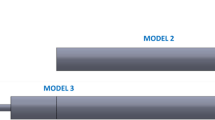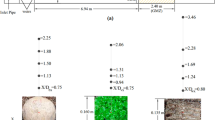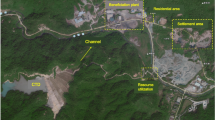Abstract
Using structured mesh to discretize the calculation region, the wind velocity and pressure distribution in front of the wind barrier under different embankment heights are investigated based on the Detached Eddy Simulation (DES) with standard Spalart-Allmaras (SA) model. The Reynolds number is 4.0×105 in this calculation. The region is three-dimensional. Since the wind barrier and trains are almost invariable cross-sections, only 25 m along the track is modeled. The height of embankment ranges from 1 m to 5 m and the wind barrier is 3 m high. The results show that the wind speed changes obviously before the wind barrier on the horizontal plane, which is 4.5 m high above the track. The speed of wind reduces gradually while approaching the wind barrier. It reaches the minimum value at a distance about 5 m before the wind barrier, and increases dramatically afterwards. The speed of wind at this location is linear with the speed of far field. The train aerodynamic coefficients decrease sharply with the increment of the embankment height. And they take up the monotonicity. Meanwhile, when the height increases from 3 m to 5 m, they just change slightly. It is concluded that the optimum anemometer location is nearly 5 m in front of the wind barrier.
Similar content being viewed by others
References
LI Ying. Experimental analysis of train aerodynamic performance in the wind area of Xinjiang [J]. Chinese Railways, 2011 (12): 1–3. (in Chinese)
FUJII T, MAEDA T, ISHIDA H, IMAI T, TANEMOTO K, SUZUKI M. Wind-induced accidents of train/vehicles and their measures in Japan [J]. Quarterly Report of Railway Techincal Research Institute, 1999, 40(1): 50–55.
MATSUMOTO M, MAEDA T. Train/vehicles wind-induced hazard and its mitigation [C]// Proceedings of the Conference On Natural Disaster Reduction, ASCE, Washington, D.C, 1996: 131–132.
IMAI T, FUJJI T, TANEMOTO K, SHIMAMURAT, MAEDA T, ISHIDA H, HIBINO Y. New train regulation method based on wind direction and velocity of natural wind against strong winds [J]. Journal of Wind Engineering and Industrial Aerodynamics, 2002, 90(12/13/14/15): 1601–1610.
HOPPMANN U, KOENIG S, TIELKES T, MATSCHKE G. A short-term strong wind prediction model for railway application: Design and verification [J]. Journal of Wind Engineering and Industrial Aerodynamics, 2002, 90(10): 1127–1134.
GAO Guang-jun, DUAN Li-li. Height of wind barrier on embankment of single railway line [J]. Journal of Central South University: Science and Technology, 2011, 42(1): 254–259. (in Chinese)
ZHNAG Jie, LIU Tang-hong. Optimization research on the slope angle of the earth type windbreak wall of xinjiang single-track railway [J]. China Railway Science, 2012, 33(2): 28–32. (in Chinese)
PAN Di-fu, LIU Hui, LI Yan-fei. A short-time forecast method for wind speed along golmud-lhasa section of qinghai-tibet railway [J]. China Railway Science, 2008, 29(5): 129–133. (in Chinese)
WANG Xiang-yang. Analysis of flow field of snow drifting disaster to embankment [J]. Journal of Railway Engineering Society, 2009 (8): 42–48. (in Chinese)
TIAN Hong-qi. Train aerodynamics [M]. Beijing: China Railway Press, 2007: 115–117. (in Chinese)
VISWANATHAN A K, SQUIRES K D, FORSYTHE J R. Detached-Eddy simulation around a fore body with rotary motion [J]. AIAA Journal, 2008, 46(9): 2191–2201.
SQUIRES K D, KRISHNAN V, FORSYTHE J R. Prediction of the flow over a circular cylinder at high Reynolds number using detached-eddy simulation source [J]. Journal of Wind Engineering and Industrial Aerodynamics, 2008, 96(10/11): 1528–1536.
CUMMINGS R M, MORTON S A, FORSYTHE J R. Detached-eddy simulation of slat and flap aerodynamics for a high-lift wing [J]. AIAA, 2004: 9860–9873.
DECK S. Zonal-detached-eddy simulation of the flow around a high-lift configuration [J]. AIAA Journal, 2005, 43(11): 2372–2384.
JOHN D. ANDERSON, J R. Computational fluid dynamics [M]. Beijing: Tsinghua University Press, 2002: 49–60.
SHUR M, SPALART P R, STRELETS M, TRAVIN A. Detached-eddy simulation of an airfoil at high angle of attack [C]// 4th Int. Symposium on Eng. Turb. Modeling and Experiments, Corsica, France, 1999: 669–678.
LIANG Xi-feng, XIONG Xiao-hui, YI Shi-he. Optimization research on aerodynamic figure of the box car under crosswinds [J]. Journal of National University of Defense Technology, 2006, 28(2): 26–30. (in Chinese)
HUNT J C R, WRAY A A, MOIN P. Eddies, stream, and convergence zones in turbulent flows [R]. Center for Turbulence Research Report CTR-S88, 1988: 193–208.
Author information
Authors and Affiliations
Corresponding author
Additional information
Foundation item: Projects(51075401, U1334205) supported by the National Natural Science Foundation of China; Project(NCET-10-0833) supported by the New Century Excellent Talents in University, China; Project supported by the Scholarship Award for Excellent Innovative Doctoral Student granted by Central South University, China; Project(2012T002-E) supported by the Science and Technology Research and Development Program of Ministry of Railway, China; Project(14JJ1003) supported by the Natural Science Foundation of Hunan Province, China
Rights and permissions
About this article
Cite this article
Gao, Gj., Zhang, J. & Xiong, Xh. Location of anemometer along Lanzhou-Xinjiang railway. J. Cent. South Univ. 21, 3698–3704 (2014). https://doi.org/10.1007/s11771-014-2353-1
Received:
Accepted:
Published:
Issue Date:
DOI: https://doi.org/10.1007/s11771-014-2353-1




